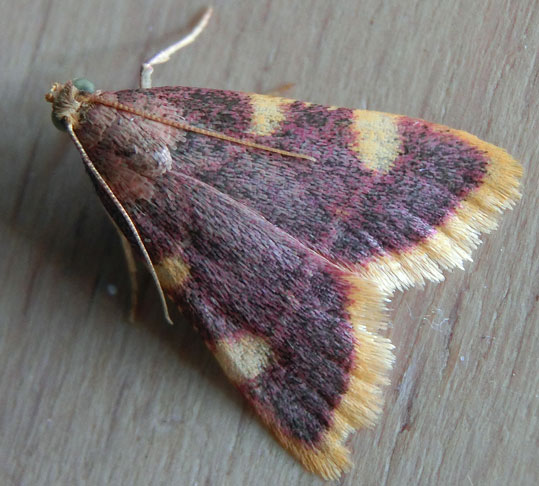Subspecies
|
Several subspecies are recognized, but only the nominate subspecies occurs in Germany.
|
Synonyms
|
Synonymy of Hypsopygia costalis costalis:
Hypsopygia costalis (Fabricius, 1775)
Hypsopygia costalis costalis (Fabricius, 1775)
Hypsopygia fimbrialis (Denis et Schiffermüller, 1775)
Hypsopygia costalis rubrocilialis (Staudinger, 1870) (infrasubspecific)
|
Identification
|
Wing
span 14 - 23 mm. Ground color purple brown, in lighter specimens even
pinkish-red. The anteromedial and postmedial lines are golden-yellow and
broaden towards the costal margin. The fringes are golden-yellow. Some
specimens may have all yellow elements violet-red instead ("forma
rubrocilialis").
Larva: whitish or brownish, head red brown and yellow neck shield.
|
Distribution
|
A
widely distributed and common species. All of Europe (except for
northern parts), northern Africa, western Asia, north and south America.
In Germany recorded from all Bundesländer.
|
Biology
|
A
synanthropic species that is frequently found in houses, but also in
several other kinds of habitats (e.g. steppe, forests and forest edges).
The larva lives in silken tubes in plant material e.g. hay and leaf
litter, bird nests and squirrel nests. Flight season May to July and a
partial second generation to October (but may be found the year round in
houses). The larva lives from September and overwintering to May. It
pupates in an oval cocoon directly where it feeds.
The imagines become active at dawn and are attracted to light at night.
During the day the animals hide in the vegetation or hey and other plant
detritus and, when disturbed, fly only small distances and immediately
hide again.
|
|
|
Specimen photographed in Frankfurt am Main (Hessen) on September 28, 2014.
Specimen photographed in Köln (Nordrhein-Westfalen) in 2001.
|
|


